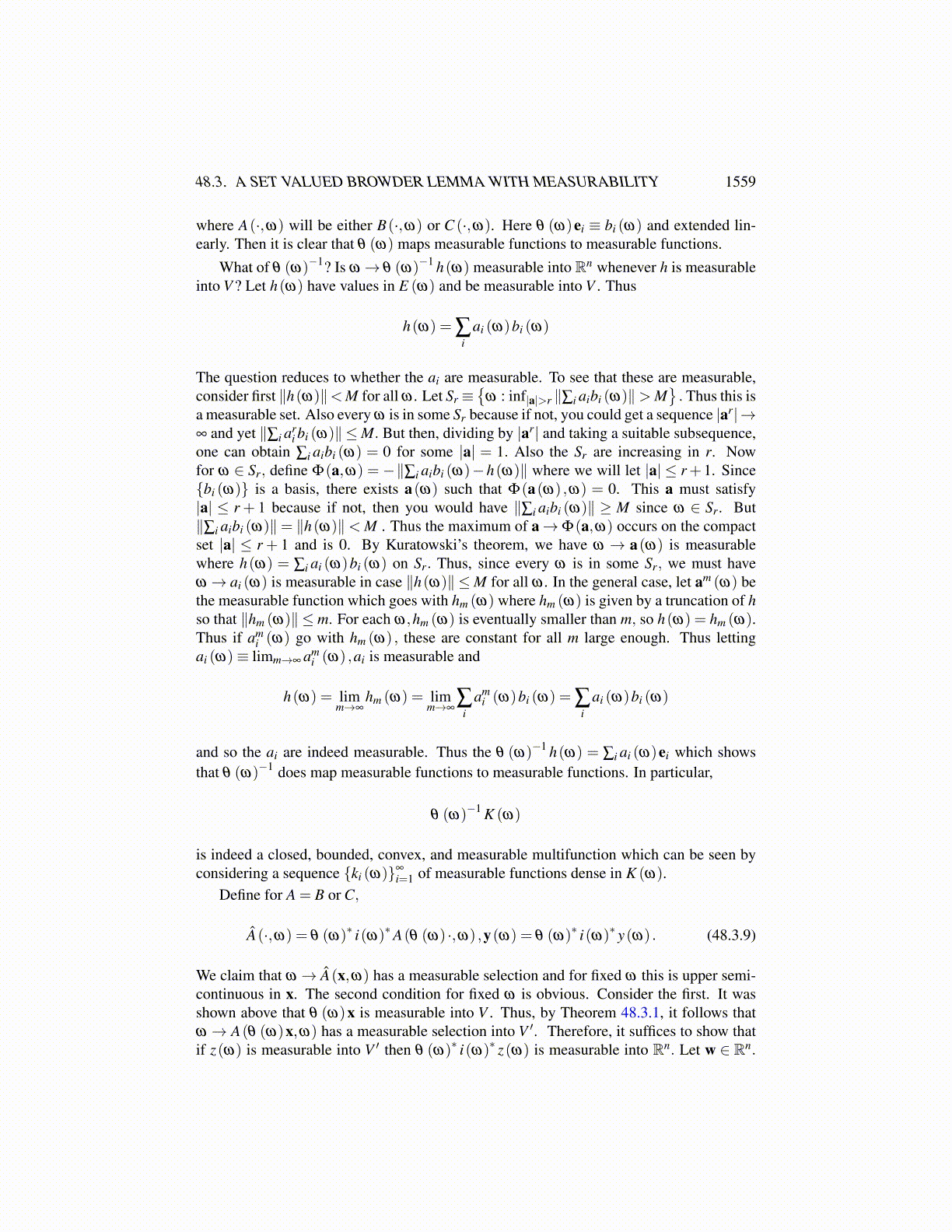
48.3. A SET VALUED BROWDER LEMMA WITH MEASURABILITY 1559
each cnk being in V . We can assume that ∥un (ω)∥ ≤ 2∥u(ω)∥ for all ω . Then, by as-
sumption, there is a measurable selection for ω→ A(cn
k ,ω)
denoted as ω→ ynk (ω) . Thus,
ω → ynk (ω) is measurable into V ′ and yn
k (ω) ∈ A(cn
k ,ω)
for all ω ∈Ω. Consider now,
yn (ω) =mn
∑k=1
ynk (ω)XEn
k(ω) .
It is measurable and for ω ∈ Enk it equals yn
k (ω) ∈ A(cn
k ,ω)= A(un (ω) ,ω) . Thus, yn
is a measurable selection of ω → A(un (ω) ,ω) . By the assumption A(·,ω) is bounded,for each ω these yn (ω) lie in a bounded subset of V ′. The bound might depend on ω
of course. It follows now from Lemma 48.2.2 that there is a subsequence{
yn(ω)}
thatconverges weakly to y(ω), where ω → y(ω) is measurable. But,
yn(ω) (ω) ∈ A(un(ω) (ω) ,ω
)is a convex closed set for which u→ A(u,ω) is upper-semicontinuous and un(ω) → u,hence, y(ω) ∈ A(u(ω) ,ω). This is the claimed measurable selection.
The next lemma is about the projection map onto a set valued map whose values areclosed convex sets.
Lemma 48.3.2 Let ω →K (ω) be measurable into Rn where K (ω) is closed and con-vex. Then ω → PK (ω)u(ω) is also measurable into Rn if ω → u(ω) is measurable. HerePK (ω) is the projection map giving the closest point.
Proof: It follows from standard results on measurable multi-functions [70] also inTheorem 48.1.2 above that there is a countable collection {wn (ω)} , ω → wn (ω) beingmeasurable and wn (ω) ∈K (ω) for each ω such that for each ω, K (ω) = ∪nwn (ω). Let
dn (ω)≡min{∥u(ω)−wk (ω)∥ ,k ≤ n}
Let u1 (ω)≡ w1 (ω) . Letu2 (ω) = w1 (ω)
on the set{ω : ∥u(ω)−w1 (ω)∥< {∥u(ω)−w2 (ω)∥}}
andu2 (ω)≡ w2 (ω) off the above set.
Thus ∥u2 (ω)−u(ω)∥= d2. Let
u3 (ω) = w1 (ω) on{
ω : ∥u(ω)−w1 (ω)∥<∥∥u(ω)−w j (ω)
∥∥ , j = 2,3
}≡ S1
u3 (ω) = w2 (ω) on S1∩{
ω : ∥u(ω)−w1 (ω)∥<∥∥u(ω)−w j (ω)
∥∥ , j = 3
}u3 (ω) = w3 (ω) on the remainder of Ω